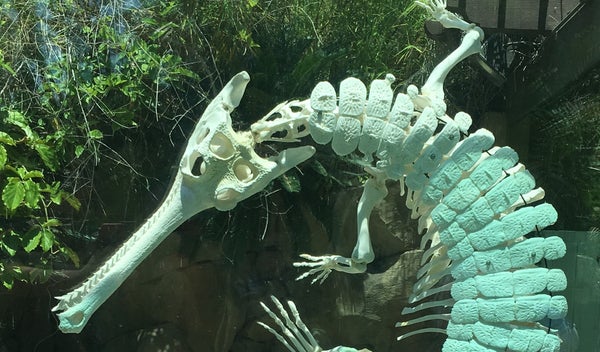This article was published in Scientific American’s former blog network and reflects the views of the author, not necessarily those of Scientific American
Science is full of arcane terminology. Why use an easy-to-understand or evocative word when an opaque and overwrought phrase will do? But there are exceptions. Like “death roll.”
If you grew up watching David Attenborough specials, you’ve probably heard the term over slow-motion footage of crocodiles tearing wildebeest apart. It means exactly what you think. The behavior is the powerful and violent twisting that wrenches limbs from sockets and muscle from bone when a crocodylian clamps onto a morsel and does its best impression of a washer on spin cycle. The process is so fascinating that the flashes of white teeth and red innards are deemed suitable for broadcast, even if momentarily.
Do all crocs do this? American alligators, saltwater crocodiles, and Nile crocodiles have gotten a fair amount of press for the skill, but there are over 20 other living species. Not to mention the burgeoning ranks of fossilized snappers, including monsters like the 40 foot-long alligator relative Deinosuchus. If we can understand a bit more about the modern incarnation of the death roll, perhaps we can get a better idea of whether crocs of the past employed the same terrible twirls.
On supporting science journalism
If you're enjoying this article, consider supporting our award-winning journalism by subscribing. By purchasing a subscription you are helping to ensure the future of impactful stories about the discoveries and ideas shaping our world today.
Up until now, paleontologist Stephanie Drumheller and colleagues note, experts have assumed that only “generalist” crocodylians with long, broad snouts death rolled. The same was thought to be true for extinct species. But when Drumheller, James Darlington, and Kent Vliet went straight to the source – studying living crocs presented with bait and capture tools – the researchers found something different. All modern species, save for one, can do the death roll.
The crocs volunteered for the project represented 25 living species, all held at the St. Augustine Alligator Farm Zoological Park in Florida. Some were animals transferred from other places, some were born at the park, and others were captured as “nuisance” animals, the researchers write, carrying between them a variety of backgrounds and even anatomies related to their life history. Each test animal was presented with two different behavioral cues during the study – a bait on which resistance would be applied after a bite, and the second was a rope or pole normally used to capture crocs which often prompts the animals to try to escape.
Only a single species out of 25 – Cuvier’s dwarf caiman – didn’t death roll under either circumstance. (This doesn’t mean that the caiman can’t, or won’t, but only that it didn't under the circumstances of the trials.) All the rest did, which runs contrary to prior assumptions. Previous studies thought that the twisting forces generated by death roll behavior would be too damaging to slender-snouted crocodylian species, like gharials, yet even these animals rolled. The more slender species might not need to rip and tear, but, as Drumheller and coauthors write, “This is not the first study to determine that some crocodylian species seem to over-shoot the apparent requirements of their niche.”
The upshot is that death roll behavior isn’t restricted to just a few special croc subsets, but is ubiquitous through the family despite differences in size, snout shape, or whether the animals in the study were captive born or wild. In evolutionary terms, the results mean that the ability to death roll may have been present in the last common ancestor of all modern crocodylians. It’s perfectly reasonable to imagine a lurking Deinosuchus launching itself from the water to twist off a fresh hadrosaur drumstick. But the focus on feeding misses the larger point. The death roll isn’t all about eating, or even death. For many crocs, it’s self defense.
“Death rolling behavior may have nothing to do with feeding strategy at all,” Drumheller and colleagues write. Crocodylians of all sorts fight with each other by biting, often along the head, legs, and the base of the tail. There are even fossils that show similar injuries. Biting and twisting is part of the combat repertoire, either to injure and opponent or escape. The “death roll” may actually be a “combat roll,” evolved as part of croc confrontation and then later co-opted by the chompier species to rip chunks off their dinners. And given how long crocs of all sorts have persisted through evolutionary time, they’ll keep rolling on.
